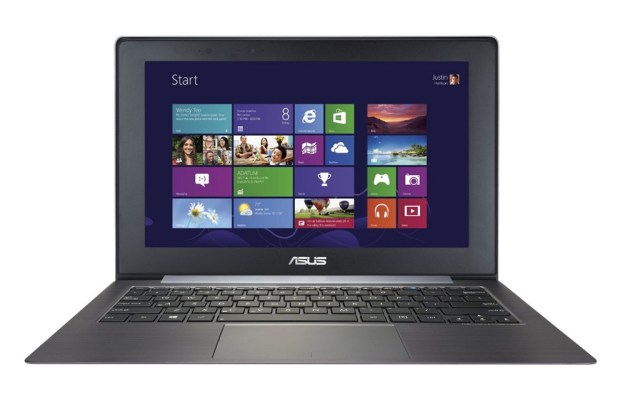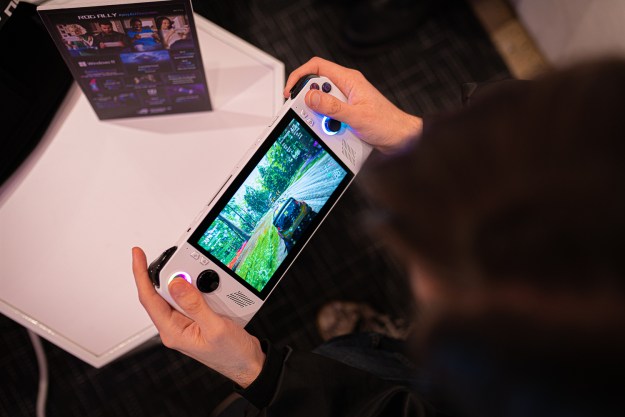
“The Asus Taichi 21 is undoubtedly novel and its design is interesting. A laptop with two screens that isn't bulky or needlessly gimmicky, the Taichi hopes to stand above the Windows 8 competition. But double the screen doesn't mean double the fun.”
- Innovative design and concept
- Light for a laptop even with two displays
- Full HD resolution on both displays
- Outer display is touch and stylus-enabled
- Short battery life
- Heavy for a tablet
- Uncomfortably high temperatures on the bottom
- Few ports
- No apps to take advantage of dual-screen design
- Performance goes down in Dual-Screen Mode
Whether or not you’re a fan of Windows 8, you have to admit that it has inspired laptop makers to get seriously creative with their designs. Some of it is an effort to take advantage of the operating system’s features and functions, but a lot of it is clearly peacock-level posturing. You can almost hear the companies saying I can make a more innovative PC than you can! as they show off displays that detach or twist 360 degrees.
Asus pioneered the tablet/keyboard dock form factor, so it’s possible the company felt the need to up the ante to get attention in a Windows 8 world. Enter the Taichi 21, a laptop/tablet hybrid with not one, but two displays. The extra screen on the lid opens up interesting possibilities for mainstream consumers, artistic types, and the enterprise set. It’s an innovative idea, but that doesn’t guarantee that the Taichi is a laptop worth owning – especially for $1,600.
Instead of bending over backwards like the Yoga, the Taichi offers you four different ways to use it: as a normal laptop (Notebook Mode), as a Windows tablet (Tablet Mode), and as a dual-screened device (Mirror and Dual-Screen Modes).
We flipped for the Dell XPS 12 and found inner peace with the Lenovo Yoga, but will the Taichi kick them both to the curb?
Notebook Mode
The Taichi is just like any other W8 Ultrabook when in Notebook Mode. It has an island-style, backlit keyboard; large, a buttonless touchpad; a slim profile (0.7-inches thick); and an impressively light weight of just 2.8 pounds. The general design language reminds us of the Zenbook series (with less shine), as do the keyboard and touchpad.
Even though the travel is shallow due to the laptop’s thinness, typing was still comfortable. There’s no firm tactile feedback, mushiness, or sticky or undersized keys, but the same can’t be said about the touchpad. The bottom left side on our review unit was stiff, which made clicking harder than usual.
A wide bezel surrounds the bright 11.6-inch IPS display. Color quality and contrast are good, and the Taichi is blessed with wide viewing angles. The full HD 1920 x 1080 pixel resolution means that text is crisp and HD videos look their best. Unfortunately, it also means that certain interface elements are tiny, which is most apparent when using desktop apps. Full-screen Windows 8 apps look better and didn’t make us squint.
Another drawback to this particular screen is that it’s not touch enabled. Granted, a laptop with two touchscreens would probably be excessively expensive, so this is not a deal breaker. Still, we often reached up to swipe the screen, forgetting that there wasn’t a touchscreen there.
The Taichi is lacking in ports – a trait we’re unfortunately coming to expect with Ultrabooks. Still, the absent memory card reader is very disappointing. Though there are just two USB ports, they’re fortunately both version 3.0, making it possible to connect powerful peripherals. The Taichi also has a mini VGA and a micro HDMI port plus a combo headphone/mic jack. We’re not so into having mini/micro ports as it means some will have to buy new cables. A mini VGA-to-VGA dongle comes with the laptop, as does a USB-to-Ethernet dongle (they even have their own carrying pouch). Some don’t mind having to keep track of such accessories; others find it a hassle.
Tablet Mode
Closing the lid of the Taichi will automatically switch it to Tablet mode, activating the display on the lid. This 10-finger IPS touchscreen is a bit brighter than the one inside, but is otherwise the same size and resolution. The accelerometer activates in Tablet Mode, so you can hold the Taichi in portrait or landscape to work, play, or watch.
Readers might be thinking: what if you want to close the lid to put the laptop to sleep and not switch to the tablet? A switch on the left edge of the machine disables Tablet Mode and puts the machine to sleep when the lid closes. You have to remember to flip it on and off, though.
We found the display sensitive enough and accurate, even when dealing with less than touch-friendly desktop apps. It accurately recorded taps, gestures, and swipes, making for a great Windows 8 experience overall.
The more expensive configuration of the Taichi comes with a digitized stylus. There’s nowhere to store this pen inside the laptop’s body, but the included protective sleeve does have a place for it. Styluses may seem old school to some, but they do provide useful enhancements, especially in the realm of productivity.

Though we enjoyed Tablet Mode, we ran into the same issue we did with the Dell XPS 12: it’s just too heavy for a tablet. In this case, the Taichi is over a pound lighter than the XPS 12, making it heavy to hold after a few minutes – an issue missing from detachable tablets.
Asus doesn’t bog the Taichi down with too many pre-loaded apps, but it does include a few perfect for tablet mode. We particularly like Supernote, a robust program that allows for both text and freehand input. There are also a couple of free games that work great on a touchscreen.
Mirror Mode and Dual-Screen Mode
Now we get to the fun part. You have two choices when working with both displays at once: showing the same content on both (Mirror Mode), or using the lid monitor separately (Dual-Screen Mode). A button on the top row of the keyboard brings up the Taichi launcher to facilitate switching between these and the other two modes.
Mirror Mode’s most practical uses are mostly in the realm of the enterprise user, and Asus touts it as a great tool for presentations. However, the company also mentions that it’s a good way for a group of people to watch a video – everyone doesn’t have to crowd in front. In this mode, both displays are active, so you can control it via touch from the back or with the mouse and keyboard in front.
Dual-Screen Mode allows the display on the lid to act as a second monitor, similar to connecting an external one. You can drag programs and windows from one screen to the other, though doing so is a bit awkward. Again, the most practical use is business-related (presentations).
Asus’ claim that the Taichi becomes two computers in this mode is highly suspect. It’s still one computer – just with two monitors. And though it’s possible to control either screen from both sides, they can’t really be controlled simultaneously. If the person in front of the keyboard is moving the mouse and the person on the other side decides to tap the screen, the mouse cursor will jump to the second screen.
Using the Screen Share utility, you can see what’s happening on the second screen while looking at the first, but the performance here isn’t smooth at all. The little window will show a low frame rate version of what’s happening on the other side. This is fine for presentations, but not for competitive games or interaction.
Another drawback is that there aren’t any other programs or apps made to take advantage of these modes. This may change in the future, especially if the Taichi sells well. Unless you’re into presentations or watching videos with large groups, these modes are wasted.
Double displays do not equal twice the performance
Powering two displays also cuts into performance. The unit we tested, the Asus Taichi 21-DH71, came with a 1.9GHz Intel Core i7-3517U processor, 4GB of RAM, and a 256GB solid-state drive. This configuration sells for $1,600. A less expensive configuration, featuring a 1.7GHz Intel Core i5-3317U chip, 4GB of RAM, and a 128GB SSD, costs $1,300. However, if you intend to use the Mirror or Dual-Screen Modes, we suggest getting the more expensive version.
The Taichi earned a combined score of 42 GOPS in SiSoft Sandra’s Processor Arithmetic test and a score of 8,203 in 7-Zip. Neither of these scores is stunning, but they’re in line with other Ultrabooks with the same chip, such as the Acer Aspire S7.

Adding to the problem is the Asus Power4Gear power profiles. Switching to Dual-Screen automatically activates the power-saving profile, resulting in noticeably slower performance. Switching to a high performance profile before running the benchmark sped things back up, but it still didn’t result in the same performance as in Notebook Mode.
In Notebook Mode, our 3DMark 06 and 3DMark 11 test scores came to 3,962 and 583, respectively. The first score is well below both the Aspire S7 and the XPS 12, marking a laptop that can only handle some casual games. Though you have a full HD display, don’t count on being able to play games at that resolution. HD video playback proved smooth, however, and the Bang & Olufsen ICEpower speakers delivered impressive sound.
We didn’t note any performance issues while using the Taichi in Notebook and Tablet modes. However, when transferring files from external drives to the laptop, copying took longer than we’d expect from an SSD.
Quiet, but toasty
When running benchmarks, we noticed that heat on the bottom of the Taichi quickly went from uncomfortable to hot. With the highest temperatures in the back, we couldn’t keep the laptop on our lap, and holding it in tablet mode was also difficult. We never heard the fan noise. We’re not sure if that’s because it never came on or if it was just very quiet.
It didn’t take intense benchmarking to raise the heat level. Playing games and watching video also made for uncomfortable temperatures, which isn’t great for a device meant to be held in the hand or set in a lap.
Don’t forget the power cord
The Taichi has a bigger footprint than we’re used to in an 11.6-inch laptop, but, at 2.8 pounds, it’s still a light and slim machine. It’s the same weight as the average netbook and comes with a small AC adapter – which you’ll need to take with you at all times.
Depending on the mode, battery life differs but is overall unimpressive. In Notebook Mode, the Taichi lasted just 2 hours and 24 minutes in the Peacekeeper browser test. When using the machine for work – heavy Web browsing, multitasking with five to nine programs, and having dozens of tabs open – it lasted just over 4 hours. This is low even for an Ultrabook.
Tablet Mode is on par with this, lasting for 2 hours and 27 minutes. The Taichi is greedier in Dual-Screen Mode, lasting 1 hour and 48 minutes. That last score isn’t too bad considering both displays are on, and screens are one of the biggest battery hogs on a laptop.
Conclusion
Oh Asus, you tried so hard to impress us with the Taichi 21 – and it worked … at first. The idea behind this hybrid is cool and different, and we want to like it. We wish the battery life was a little longer, the bottom was less toasty, and the Taichi had some apps that make the two screens less of a novelty and more of a must-have feature. Alas, that is not the case, and we’re genuinely sad to say so.
That last issue is the most solvable of the three. If developers get creative, there is huge potential here. Even so, at $1,600 will consumers look past the Asus Taichi 21’s other drawbacks even if they’re excited by the concept? Sometimes practicality has to trump neat ideas.
Highs
- Innovative design and concept
- Light for a laptop even with two displays
- Full HD resolution on both displays
- Outer display is touch and stylus-enabled
Lows
- Short battery life
- Heavy for a tablet
- Uncomfortably high temperatures on the bottom
- Few ports
- No apps to take advantage of dual-screen design
- Performance goes down in Dual-Screen Mode
Editors' Recommendations
- The 6 best laptops for seniors in 2024
- Best 14-inch laptops for 2024: tested and reviewed
- Asus’ forgotten ROG Ally is now totally worth the money
- This sleeper Asus laptop is faster and cheaper than Microsoft’s Surface Laptop Go 3
- A major Asus ROG Ally challenger could be in the works






